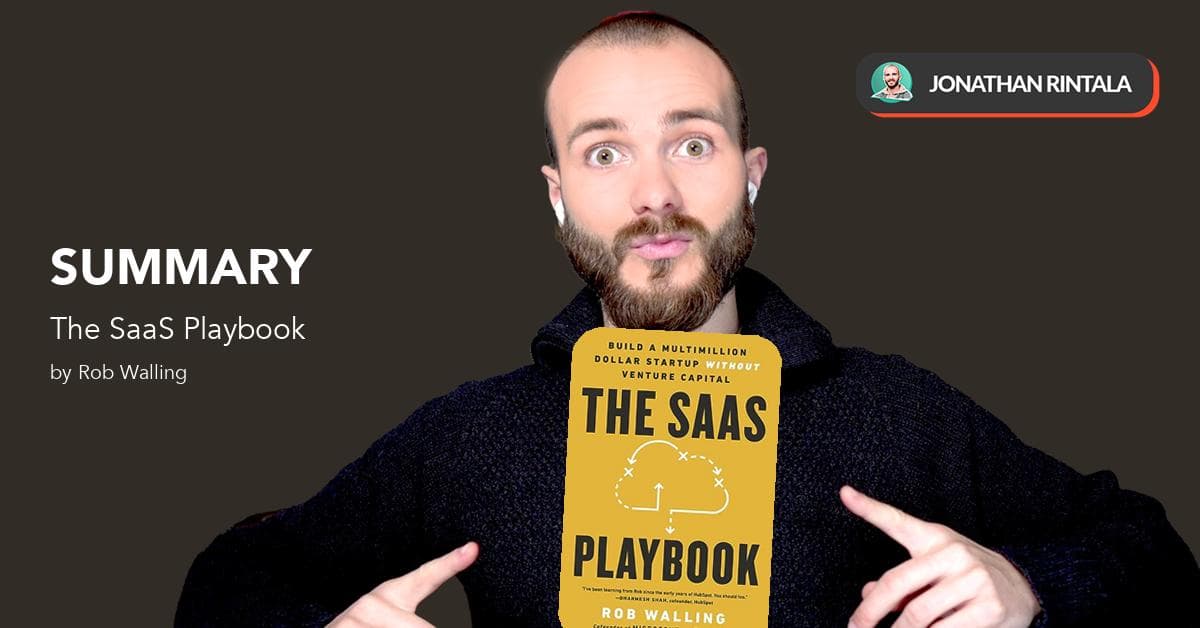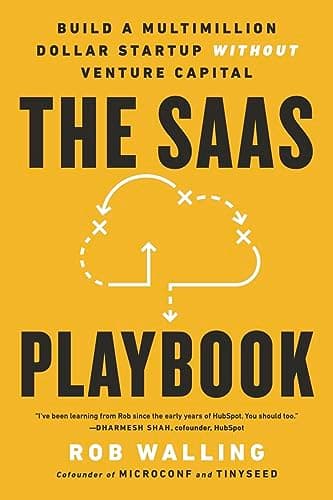The SaaS Playbook - Summary and review

🚀 Summary: The SaaS Playbook in 30 seconds

Contents
What is The SaaS Playbook about
The SaaS Playbook
🚨 As first time founder, without prior experience or funding - be careful going in to highly competitive markets, trying to disrupt status quo.
How to compete in a competitive market? 👊
Entering a competitive market has one major advantage - the market is already proven. Ie. there is existing demand and current players thriving of that demand.
Now you just need to stand out and capture a piece of that demand - easy right?
Well, easier said than done.. But here are 3 ways to penetrate and scale in a competitive market:
1. COMPETE ON PRICE 💵
Offer a less expensive and more lean product than competitors to scale.
2. COMPETE ON SALES MODEL 🔑
Offer a new way to buy - eg. be transparent with public pricing and allow customers to try your product no-touch, when competitors are primarily offering high-touch sales with gated products.
Examples: Univid vs. ON24, Drip vs Marketo
3. COMPETE ON PRODUCT 💎
Offer superior UX or more streamlined features to win over larger competition.
Examples: Pipedrive vs. Salesforce
How to market against large competitors
Let’s say you have a larger competitor called “MegaCorp” that you compete with. How to win? Well, use their size and strength against them. Big companies like MegaCorp tend to be:
slow to react to market
offer a dated UX
have legacy code
offer bad customer support - “it’s just numbers”
etc..
Find groups of users that are frustrated with using MegaCrop and they will happily tell others within these inner circles - creating strong word of mouth.
💡 Practical tip: One way to navigate these unhappy customers and get some indicators on what segments they belong to - could be to check out comparison sites like G2, or Capterra, and then sort on reviews around 2-3 stars.
“Lightweight Marketing Automation That Doesn’t Suck”.
Drip’s headline on their website above - the scrappy new underdog
Hey, a friendly reminder - worry less about competition 🤘
Stay alert on big releases, fundraising events, and industry news - but don’t obsess over competitors.. 🔎
What you should do:
✅ Track lost deals - and WHY. How do you make sure prospects choose you next time? Can you build these features, integrations, add certifications, or adjust pricing?
If you’re in a CRM like HubSpot - set up a process for adding mandatory note when moving a deal to closed lost - to what competitor, why, etc. Share these deals with the team on Slack, bring it up on your weekly meetings, and prioritize your product roadmap based on this.
✅ CTRL+C - no worries: Don’t worry about getting copied (you will, if you do things right).
BUT there are ways to make copying you more difficult, ie. moats. Even ones specific to SaaS. Check them out below.
The 4 moats of SaaS to build - scale and defend against your competition
Below are 4 types of moats in SaaS that you can build to become less of a commodity, make copying you more difficult, and let you win more deals.
MOAT 1: 🔗 INTEGRATIONS (NETWORK EFFECT)
Networks are excellent moats - something The Cold Start Problem by Andrew Chen spends an entire book talking about. Examples involve marketplaces like eBay, Uber, or Craigslist with buyers and sellers already on their platforms.
For SaaS - typically integrations are the primary driver of the network effect moat.
A good SaaS example is Zapier - who does not just integrate to over 3,000 apps, but also built a bunch of custom integrations to non-public API:s that become really difficult to copy.
MOAT 2: 💪 A STRONG BRAND
Brand is not just logos and colors - it’s your reputation, ie. “What people say about your company when you are not around”.
You having a brand means you are no longer a commodity
A strong brand means people will trust you - and word of mouth will start to bubble - as people bring up your company in conversations, on LinkedIn, podcasts, webinars, and to their colleagues.
Let’s list CRM systems.. Well, there are 100s of them - but it’s likely you thought of at least one of the following: HubSpot, Pipedrive, Salesforce.
And it’s not because of their features. But rather because they built strong brands that people trust.
Note: positioning is part of your brand. Creating a strong positioning in a sub nische, despite having a similar offer as another product, can be one way to build a moat. As people will associate your product so strongly with the sub nische. Reading tip on positioning for SaaS: Obviously Awesome by April Dunford
MOAT 3: 🚦 OWNED TRAFFIC CHANNELS
Owning demand and your own channels can be a huge moat. This could be:
having a big following on TikTok or Youtube
distributing a large newsletter to decision makers
having the largest podcast in the industry
being exceptional at SEO and get 100K unique monthly visitors
Note: that these can all be quite sensitive to changes in algorithms, so there are platform risk involved and you should spread your bets.
MOAT 4: 🔒 HIGH SWITCHING COSTS
Lock your customers in, throw away the key, and you have the strongenst moats of all.. Well, maybe not exactly this like that - but if your product involves any of the below - you have a lock-in moat to your advantage:
API integrations that requires expensive developer time
customer need buy-in from lots of people to replace
critical history is stored within the tool
X4 quick moat don’t:s ❌
Don’t translate your product into other languages too soon - it often becomes a massive effort to add and maintain, beyond just the UI
Don’t white label - if there is not upfront buy-in, as you loose the brand moat and often end up wasting time
Don’t add other verticals too early - it can lead to adding alot of complexity in your product early on, instead of keeping focus narrow and dominate one niche
Don’t underprice your product - pricing can be the biggest lever to 10X your business, so don’t sell yourself short and up with impossible CAC and targets for # of customers to hit
Buy the book: The SaaS Playbook 👇
If curious in more, you can buy the full book on Amazon: Print | KindleFrequently asked questions (FAQs)

Q: Who is Rob Walling?
A serial startup founder with notable exit of SaaS platform Drip, investor in >170 startups, and author of 4 books on startups. Rob started TinySeed - the first accelerator for SaaS bootstrappers, as well as the SaaS bootstrapping community MicroConf.
Want to learn more about growing SaaS companies?

